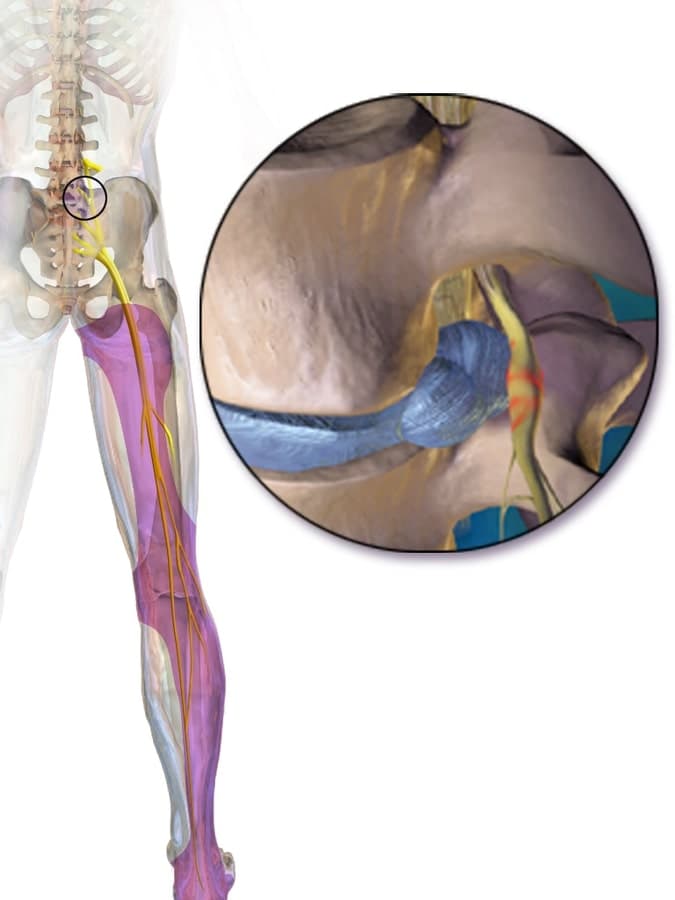Sciatic Nerve Treatment: Symptoms, Causes and Treatment

What is the Sciatic Nerve?
The sciatic nerve is a vital component of the human body's nervous system. It is the largest and longest nerve, originating from nerve roots in the lower back, specifically from the lumbar and sacral regions of the spine. The sciatic nerve is comprised of five nerve roots, namely L4, L5, S1, S2, and S3, which join together to form a single large nerve that travels through the pelvis and down each leg.
This nerve plays a crucial role in facilitating communication between the brain and the lower part of the body. It serves as a pathway for sensory and motor signals, allowing us to feel sensations and control movements in the lower limbs. When we walk, run, sit, or perform any activity that involves the legs, the sciatic nerve is actively involved in transmitting signals between the brain and the muscles.
As the sciatic nerve extends down each leg, it branches out into smaller nerves, reaching various parts of the leg, foot, and toes. These branches innervate the muscles, skin, and other structures, ensuring that our lower extremities function properly and allowing us to perceive touch, temperature, and pain sensations in the legs.
Although the sciatic nerve is essential for our daily movements and sensations, it can also become a source of immense discomfort when it is under pressure or irritation. When the nerve gets compressed or pinched due to factors like a herniated disc, bone spurs, or muscle tightness, it can lead to a condition known as sciatic nerve pain or sciatica. This pain is often described as a sharp, shooting sensation that radiates from the lower back and travels down the back of the leg, sometimes even reaching the foot.
What Causes Sciatic Nerve Pain?
Sciatic nerve pain can be caused by various factors, including herniated discs, bone spurs, spinal stenosis, piriformis syndrome, or even pregnancy. When the nerve is compressed or pinched, it results in the characteristic pain and discomfort.

Sciatic Nerve Pain Treatments
Dealing with sciatic nerve pain can be a distressing experience, but the good news is that there are various effective treatments available to provide relief and improve your quality of life. The treatment options for sciatic nerve pain can range from conservative approaches to more specialized interventions, depending on the severity and underlying cause of the pain. Let's delve into the different sciatic nerve pain treatments:
- Conservative Approaches:
- Rest and Activity Modification: Taking a break from activities that worsen the pain and incorporating gentle exercises can alleviate pressure on the sciatic nerve. It's essential to strike a balance between rest and light movements to promote healing.
- Heat and Ice Therapy: Applying heat packs or ice packs to the affected area can help reduce inflammation and ease the pain. Heat can soothe tense muscles, while cold can reduce swelling and numbness.
- Over-the-Counter Pain Medications: Non-steroidal anti-inflammatory drugs (NSAIDs) like ibuprofen or acetaminophen can provide temporary relief from sciatic nerve pain by reducing inflammation and pain.
- Physical Therapy:
- A qualified physical therapist can design a personalized exercise program to strengthen the muscles supporting the spine and pelvis. These exercises improve flexibility and reduce nerve compression, helping to alleviate sciatic nerve pain.
- Physical therapy may also include manual techniques, such as spinal manipulation or mobilization, to improve joint function and reduce pressure on the nerve.
- Chiropractic Care:
- Chiropractors are trained to perform adjustments to the spine, aiming to realign the vertebrae and reduce pressure on the sciatic nerve. Chiropractic care can provide relief for some individuals with sciatica.
- Acupuncture:
- This ancient practice involves inserting thin needles into specific points of the body to stimulate energy flow and promote healing. Acupuncture has been found to offer pain relief for some people suffering from sciatic nerve pain.
- Epidural Steroid Injections:
- For severe cases of sciatica that don't respond to conservative treatments, a healthcare professional may recommend epidural steroid injections. This procedure involves injecting a corticosteroid medication into the space around the spinal cord to reduce inflammation and relieve pain.
- Surgery:
- Surgery is considered a last resort for sciatic nerve pain and is only recommended when other treatments have failed to provide relief or if there is an underlying structural issue that requires correction. Surgical options include discectomy (removal of a herniated disc), laminectomy (removing part of the vertebral bone), or spinal fusion (joining vertebrae together).
It's important to remember that the most suitable treatment for sciatic nerve pain depends on individual factors, such as the severity of the pain, the cause of the compression, and the patient's overall health. Therefore, it is crucial to consult a healthcare professional or a specialist in spine and nerve disorders to receive a proper diagnosis and personalized treatment plan.
In addition to professional treatments, there are also self-care measures and home remedies that can complement the medical interventions and promote healing. These may include regular stretching exercises, yoga, maintaining good posture, and using ergonomic workspaces to avoid exacerbating the pain.
Home Remedies for Sciatic Nerve Pain
Home remedies and self-care practices can play a significant role in managing and alleviating sciatic nerve pain. While they may not cure the underlying cause of the pain, these natural approaches can provide relief, promote healing, and improve the overall quality of life for individuals dealing with sciatica. Here are some effective home remedies and self-care strategies to consider:
- Stretching Exercises:
- Gentle stretching exercises can help improve flexibility and reduce irritation of the sciatic nerve. Key stretches include the seated piriformis stretch, where you cross one leg over the other while sitting and gently lean forward, and the knee-to-chest stretch, where you lie on your back and bring one knee towards your chest.
- Yoga poses that focus on stretching the lower back, hips, and legs can also be beneficial in relieving sciatic nerve pain.
- Yoga and Pilates:
- Engaging in regular yoga or pilates practice can help strengthen the core muscles and improve flexibility. A stronger core can support the lower back and reduce pressure on the sciatic nerve.
- Maintain Good Posture:
- Poor posture can contribute to sciatic nerve pain, especially when sitting for prolonged periods. Maintaining proper posture while sitting, standing, and walking can help alleviate pressure on the lower back and promote spinal health.
- Ergonomic Workspace:
- For those with desk jobs, creating an ergonomic workspace is essential. Ensure that your chair provides adequate lumbar support, and your computer screen is at eye level to avoid slouching and straining the back.
- Hot and Cold Therapy:
- Alternating between heat packs and ice packs can help reduce inflammation and provide relief from sciatic nerve pain. Apply a heat pack to the affected area for 15-20 minutes to relax tense muscles, and then follow it up with a cold pack to reduce swelling and numbness.
- Mindful Movement and Avoiding Overexertion:
- Engage in activities that promote gentle movement, such as walking or swimming, to keep the body mobile and prevent stiffness. However, avoid overexertion or activities that may aggravate the pain.
- Avoid Prolonged Sitting or Standing:
- Long periods of sitting or standing can compress the sciatic nerve. If your job requires extended periods of sitting, take regular breaks to stretch and walk around.
- Proper Lifting Techniques:
- When lifting heavy objects, bend at the knees and keep the back straight to avoid putting unnecessary strain on the lower back and sciatic nerve.
- Stress Reduction:
- Chronic stress can exacerbate pain perception. Engage in relaxation techniques such as deep breathing, meditation, or mindfulness to manage stress levels and promote overall well-being.
Remember that while home remedies and self-care practices can be beneficial, they may not be sufficient for severe or persistent sciatic nerve pain. It's crucial to consult with a healthcare professional for a comprehensive assessment and personalized treatment plan. By combining self-care strategies with professional medical guidance, individuals can effectively manage sciatic nerve pain and improve their daily functioning and quality of life.
Conclusion
Sciatic nerve pain can be a debilitating condition, but there are numerous treatment options available. From conservative approaches to professional interventions, finding relief is possible. However, it's essential to consult with a healthcare professional to determine the best course of action for your specific condition.
FAQs
1. Can sciatic nerve pain go away on its own?
In some cases, mild sciatic nerve pain may resolve on its own with rest and home remedies. However, persistent or severe pain requires medical attention.
2. How long does it take to recover from sciatic nerve pain?
Recovery time varies depending on the cause and severity of the pain. Some people experience improvement within a few weeks, while others may take several months.
3. Is massage therapy effective for sciatic nerve pain?
Massage therapy can provide temporary relief by relaxing muscles and promoting blood flow, but it may not address the root cause of the pain.
4. Can obesity worsen sciatic nerve pain?
Excess weight can increase pressure on the spine, potentially exacerbating sciatic nerve pain.
5. What lifestyle changes can help prevent sciatic nerve pain?
Maintaining a healthy weight, regular exercise, and practicing good posture can help reduce the risk of developing sciatic nerve pain.
Disclaimer
The information provided in this article is for educational purposes only and should not replace professional medical advice. If you suspect you have sciatic nerve pain or are experiencing joint pain, consult a healthcare professional for proper evaluation and treatment. Remember to always prioritize your health and well-being.
DISCLAIMER
The information provided in this article is for educational purposes only and should not replace professional medical advice. If you suspect you are experiencing any type of pain, please consult a healthcare professional for proper evaluation and treatment. Remember to always prioritize your health and well-being.